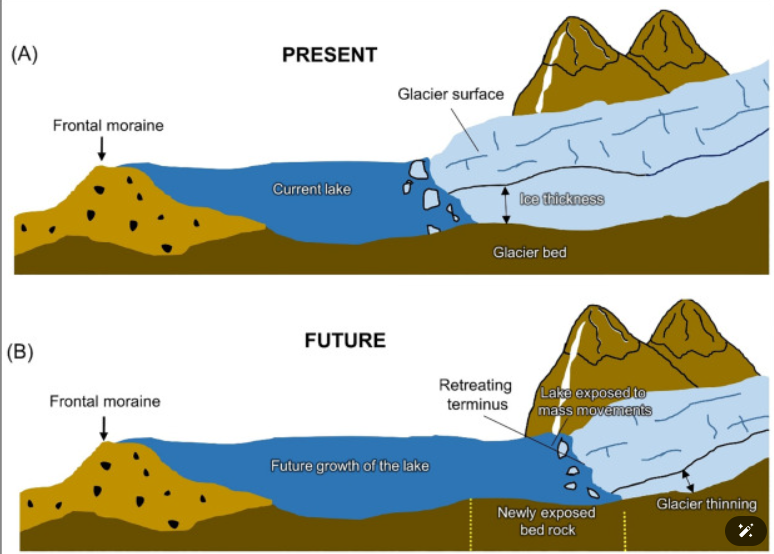-
01 Apr 2025
GS Paper 2
Geography & Economy
Day 26: What is a Glacial Lake Outburst Flood (GLOF)? Discuss its causes and implications for Himalayan regions. (38 marks)
Approach
- Define GLOF and introduce its relevance in the context of climate change.
- In the body, explain causes and analyze the implications in the Himalayan context.
- Conclude suitably.
Introduction
A Glacial Lake Outburst Flood (GLOF) refers to the sudden release of water from a glacial lake due to failure of natural dams formed by ice or moraines. In the Himalayas, GLOFs have emerged as a serious threat due to accelerated glacial retreat triggered by climate change and human interventions.
Body
- Causes of GLOF Events:
- Glacial Melting Due to Global Warming: Rising temperatures in the Himalayas are causing rapid glacier retreat and lake expansion, increasing outburst risks.
- Weak Moraine Dams: Natural dams formed by debris and moraine are often structurally weak and unable to hold increasing water pressure.
- Avalanches or Landslides into Lakes: Falling rocks, snow, or ice into glacial lakes can trigger sudden displacement of water, breaching the dam.
- Seismic Activity in Himalayan Zone: Being tectonically active, earthquakes in the region can destabilize moraine dams, causing outbursts.
- Heavy Rainfall or Cloudbursts: Extreme precipitation events, increasingly common in Himalayas, raise lake water levels abruptly, leading to overflow.
- Artificial Triggers from Infrastructure Projects: Activities like hydropower construction, tunneling, or road cutting disturb glacial and periglacial environments.
- Implications for Himalayan Regions:
- Threat to Downstream Communities: Sudden flooding from GLOFs can destroy villages, roads, bridges, and farms in narrow mountain valleys.
- Loss of Human Lives and Livelihoods: Events like the Chamoli disaster (Uttarakhand, 2021) have led to hundreds of deaths and economic disruption.
- Damage to Infrastructure and Hydropower Projects: GLOFs threaten large-scale investments in hydropower and road networks critical to mountain economies.
- Environmental Degradation: Flooding leads to erosion, siltation, and habitat destruction, affecting riverine ecosystems and biodiversity.
- Increased Disaster Risk under Climate Change: IPCC reports suggest GLOF risk will intensify due to glacial retreat and unstable lake formation.
- High Vulnerability in Eastern and Central Himalayas: Regions like Sikkim, Bhutan, Nepal, and Arunachal Pradesh have a high density of glacial lakes and steep terrain.
- Lack of Early Warning Systems (EWS): Many high-risk areas lack adequate monitoring, modelling tools, or community-level alert systems for GLOF prediction.
- Transboundary Implications: GLOFs originating in Tibet or Nepal can impact India and Bangladesh, necessitating regional cooperation and data sharing.
- Recent Concerns in 2023–24: Studies by NRSC and ICIMOD flagged more than 350 potentially dangerous glacial lakes in the Indian Himalayas.
Conclusion
GLOFs are an emerging climate-induced hazard with severe implications for Himalayan ecology and human settlements. Mitigating their risks requires glacial lake monitoring, early warning systems, risk zonation, and integration of climate resilience into development planning. Regional cooperation is also crucial for shared glacial systems.





